The group also works with kids to create safe ways for them to express their feelings about the wall and the occupation. Fatima told me she has been harassed quite a bit in her community because men think she is taking a leadership role that should be left for them, and she should be in the home.
When we curled up in her living room to do a formal interview, she was in shorts and a tank top. When I drove with her to work the next day, she was dressed in the traditional fashion; an ankle-and-wrist-covering dress and head scarf. In her home she laughs long and loud, her children crawling over each other to snuggle up with her. Walking along the street to her work, she holds herself stiffly, the shadow of a smile visible but tamed. Of course, there are many people that support her work, and she has created a network of peace activists to draw from when violence hovers. Fatima is also passing her devotion to peace and empowerment on to her daughter. Seventeen year old Shams Assi will be attending a summer camp for Palestinian and Israeli teenage girls in Colorado this summer, and hopes to bring back an understanding of wider perspectives to her village.
While exploring the streets of Ramallah, I passed a sign for the Palestine Media Center (PMC). Upon entering the building, I found one of the most well-stocked resource centers for international journalists and a very sophisticated staff eager to talk. PMC publishes the newsletter for the Palestinian Peace Coalition, which actively lobbies for a two state solution achieved through a non-violent hand-off of the West Bank and Gaza to the Palestinian Authority.
The Peace Coalition has established itself to be a pragmatic dialogue partner, advocating for measured steps and democratic involvement of the people in the process. Although they have yet to achieve the ultimate victory, the Coalition is educating Palestinians about the various options for peace and what the implications of different land divisions might be. Above all, they are committed to developing civil society, a vital ingredient of any enduring democracy.
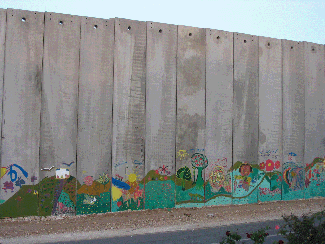
[The separation wall near Biddya, with a mural painted on it by local children]
PMC has collaborated with several international media organizations to produce stunning documentaries which look at how Palestine is portrayed in the news, and how Arabs are depicted in Hollywood films. By deconstructing the identities that have been put upon them, the staff at PMC are creating fresh space for identity exploration within Palestinian communities and in the international policy arena as well.
Also in Ramallah I caught the tail-end of a student cultural exchange in the home of Palestinian peace activist Hekmat Bessiso-Naji. Thirty Jewish and international students from Hebrew University in Jerusalem met with thirty Palestinian students from Berzeit University to get to know each other and design peace-building activities. Hekmat gets these students get together through her work with Israeli and Palestinian Faculty for Peace, in attempt to break the isolation these two populations.
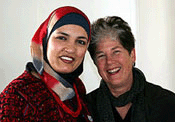
[Hekmat Bessiso-Neji with Elana Rozenman of the Interfaith Encounter, photo courtesy of Peace X Peace]
She said in an interview with me that many of the Israelis were amazed to be welcomed into a Palestinian home, and that they were seeing Palestinians in a completely different light than how they were depicted in Israeli media. On the other side, the Berzeit students were moved to see that the Israelis did not behave like soldiers, but in fact were laughing and reaching out to get to know the people towards whom they supposedly despised. Overall, events like this one help to educate both populations about the incredible humanity across all borders, and that the decisions of individuals and governments do not necessarily reflect the sentiments of the larger population.
The Interfaith Encounter Association (IEA), based in Jerusalem, also promotes cross-cultural understanding in the Middle East through the venue of religious understanding. Composed of Israeli Jews and Druze, Palestinian Christians and Muslims, and a handful of internationals of various persuasions, IEA hosts gatherings for religious people to share ideas about their practices to dispel some of the myths that have been the cause of violence. I attended the conference, held at the Hope Flowers School in Al Khadr, about 6 kilometers from Bethlehem.
Since the Oslo agreement divided Israel and Palestine into A, B and C zones and made it illegal for Israelis to travel in the West Bank and for Palestinians to travel in Israel, groups such as IEA have had a hard time meeting. This time, the Israelis took the risk and came to the West Bank illegally. I, like most internationals, have free reign over both regions. The moment of truth in the conference came when a Jewish man handed out copies of the first page of Genesis in the Bible and Torah, and the first page of the Qu’aran in English, Arabic, and Hebrew. We took turns reading them, and realized that they all basically say the same thing. These three religions which have been at war with each other for centuries are all built on the same conceptual foundation. In that pause, we were able to see the potential for more cooperation between religious groups in pursuit of peace.
The Hope Flowers School itself deserves mention. It was founded by Ibrahim Issa, who was made a refugee in 1948 and tried to raise his family in the Dheisheh refugee camp with a sense of dignity and hope. The school educates Christian and Muslim Palestinian children from kindergarten through 6th grade with a peace and democracy-based curriculum, celebrating Palestinian culture with public murals and operating with solar panels on the roof and a greenhouse to grow food for the children’s lunches. Hope Flowers has mandatory Hebrew classes for all children, as well as cultural exchanges with Israeli students and teachers and a sister school in Herzlia, Israel. Recognizing that the male heads of household in many Palestinian homes have been killed or are in prison, the school provides a safe place for children during the day so their mothers may go to work.
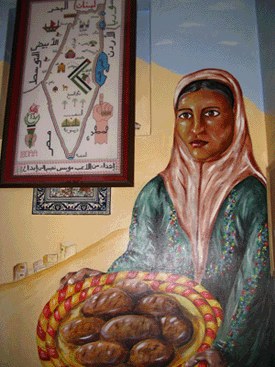
[Mural of Palestinian woman, Hope Flowers School, Al Khadr]
The Bethlehem Peace Center has a not-so-peaceful history, having been used as headquarters by the IDF during their 38-day siege on the city in 2002, after the second Intifada, when Palestinians sought refuge from the military in the Church of the Nativity across the street. Now, the Peace Center is thriving in the midst of a war-torn city. It has three beautiful galleries celebrating Palestinian artists, a conference center, and bookstore full of Palestinian authors and political commentary. It is a community hub and provides inspiration for locals and visitors.
Just a few kilometers outside of Bethlehem, Dheisheh Refugee Camp has hovered on the brink of despair since its founding in 1948. Overcrowding, lack of basic resources, and the indignity of having to buy water from their own wells back from Israel has created severe dissatisfaction in the camp. The Ibdaa Cultural Center was created ten years ago to provide a venue for youth to rise above the limitations of the camp.
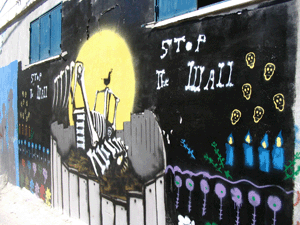
[Mural inside Ibdaa Cultural Center]
Ibdaa has proved itself to be one of the most vibrant resources in the West Bank, transforming Dheisheh into a real community. The building itself is a four story cinderblock mass, not much to see on the outside, but inside, every inch of space in the vast stairwell is covered with murals. The paintings explain the origin of camp, the history of its development, the reality of Palestinian refugees, and their dreams for the future. On the ground floor, a media lab filled with computers is there to help kids become tech-savvy and globally connected, and glass cases full of embroidery from the Women’s Artisan Collective are on sale, a cultural preservation and income generating 2-in-1 project.
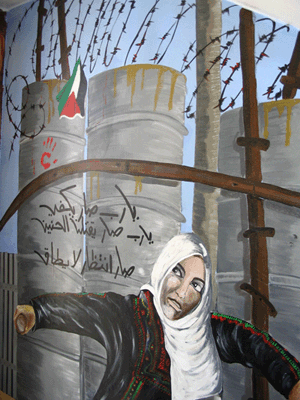
[Mural inside Ibdaa Cultural Center, depicting the second Intifada]
The second floor of Ibdaa boasts a dormitory big enough to hold visiting delegations and international volunteers, and the third floor has a performance hall for the now world famous dance troupe. Jihad Ramadan, my 23-year old guide and translator, got involved with Ibdaa as a dancer, and now mainly runs the media lab. He showed me the restaurant on the fourth floor which is ready to serve meals for locals and guests, and then we walked to a nearby building to see the crowning jewel of Ibdaa, Radio 194.
The Palestinian right to return is established by UN Referendum 194, and the taking of this name for the radio station is a brazen assertion of that right. The station is still awaiting approval from the Palestinian Authority to put up a transmitter and broadcast locally, but in the meantime, they make shows that air on KPFA radio in Berkeley. KPFA has sent them equipment and an occasional engineer to help train the volunteer engineers of Ibdaa, and in this way, the refugees are getting their stories out to the US.
Cultural centers as community resource centers are a great idea anywhere, and in the war-torn West Bank city of Nablus, it couldn’t be more needed. I was walking through the old city with a friend, conversing in English about the dire situation in Nablis, when a young woman, her hair hidden beneath a colorful scarf turned to us and said, “excuse me, I am the Arabic-English translator for the Nablus Cultural Center, perhaps you would like to see it?” So we followed her up stone stairs to a massive building complex which she explained was an old soap factory that had fallen out of us after the first Intifada. Nablus used to be the main region for olive oil soap production in Palestine. Production stopped not only because consumers began to demand “modern,” synthetic soaps instead of the old-fashioned pure olive oil ones (that incidentally have become the latest vogue in US health stores), but also because road blocks prohibited the export economy to function and there was too much soap for only domestic consumption.
The translator walked us though the building, pointing out a cistern for olive pressing that was at least a century old, and explaining what the rooms would be used for once the new center was complete; media training centers, English classes, cultural events. She said the building had been bombed several times but that hopefully it wouldn’t be now that they were pouring money into it to rebuild, and she showed us the most remarkable art display. Doors that had been recovered from bombed homes around Nablus had been turned into artist palettes for children in an art therapy group. The Center plans to organize more programs like that in the future, and they eagerly open their doors to international volunteers.
Everywhere I went in Palestine, I was almost always the only international. Since the second Intifada, Palestine has become severely isolated, as the media coverage of violence scares away all but the most determined travelers. Since I’ve returned to the USA, people keep asking if I felt in any danger during my trip, and I said yes, in Israel. The dual edge there of heavily armed Israeli Defense Force soldiers on every corner and the threat of suicide bombings did keep me on my toes. But in Palestine, I felt not only safe, but welcomed. The one English word most Palestinians know is “welcome,” and people said it to me everywhere I went. And I think they meant it.
The question that kept nagging me throughout my trip was – where is the international support? The slanted media horror stories of suicide bombings and IDF gunfire have prevented more than a few well-intentioned travelers from making the journey to Palestine and seeing for themselves what the country has to offer and how it is surviving the occupation. When I interviewed Palestinian activists and I asked them about the role of internationals, they all said something like, “you just have to come here.” Financial support does come in from abroad, from a range including USAID, Catholic Relief Services, and the government of the Netherlands. Walking through the markets, hearing the Arabic cascading out of the shops and into the falafel-scented streets, seeing the desert landscape and feeling the vibrant pulse of the people is incomparable to anywhere else. “Just buy your ticket and come to Palestine,” insists Hekmat into the microphone, perched on the sofa of her Ramallah home. “We will take care of you when you get here.”
This is the first article in a series on Israel and Palestine Mneesha Gellman will be writing for Toward Freedom.
